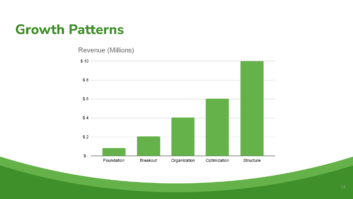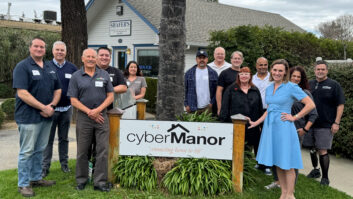Things have picked up for a lot of custom installation companies in the past few months. If companies were already busy, they are now even busier. Where business had slowed a bit post 9/11, old clients are now taking their projects off of hold and new clients are asking for proposals like there is no tomorrow. It’s getting hectic again–getting busy. Your “busyness” is starting to boom again.
Yes, your “busyness”–it’s not a typo–because if your company is like many custom installation firms, your daily activities and the things that occupy your time and keep you busy truly determine what gets done. Instead of the owner or the general manager driving the business to be what they want it to become, just the opposite happens–the busyness drives the business. The end result is that the business often doesn’t get steered in the strategic direction that it needs to go to grow profits and equity for the shareholders while increasing long-term security for the employees. Instead, it may be allowed to drift aimlessly wherever it wants to go, pushed by the specifics of the local market and the inaction or reactive actions of the management. Remember that ships left adrift eventually hit a reef and break apart, and it’s no different for businesses. It may be time for your company to put a stake in the ground and not only define what you want the business to really become, but take the necessary steps to make any changes that might be required.
Taking true control of a business to get out of “busyness” involves four simple steps: 1) Envision the Future. 2) Present the Present. 3) Connect the Disconnects. 4) Solution the Solutions. Even if your company is at a point where the last thing you need is more change and chaos, at the very least you should go through the exercise to understand where your issues lie and what future changes might be required.
Start by envisioning what you want your custom installation business to look like, ideally, in the future. If you are aggressive, you might pick a date only 6-12 months away. Or, you might choose a timeframe measured in years rather than months. Use whatever you are most comfortable with. Often, to answer this important question you need to ask yourself other questions. What is it you really deliver to your clients? Who do you want as clients? Do you want to work on a few big projects or lots of smaller to mid-sized ones? What type of systems do you want to sell? Do you even want to sell products at all, or just solutions and experiences? What about new vs. retrofit jobs? What percent of revenues should come from product markups, design fees, installation, project management fees, general contracting margins, service agreements, etc? Are there any reoccurring revenue streams that can help increase the company’s valuation down the road? What related products or service might we offer to gain more mindshare with our clients? Do you want to be perceived as an “electronic architect” or “systems designer” rather than as a subcontractor or “stereo company”?
Assume for a moment that your hypothetical company wants to focus more on being an “electronic architect.” You like the prestige and influence that the architect wields on your jobs, so you would like to do the same thing except using electronics instead of lumber. You also like the large design fees and wonderful cash flow generated by these fees. We will further assume more than 70 percent of the company’s revenue is projected to come from fees and services vs. product markups. What you are doing is laying the groundwork or vision for the company’s future.
The next step involves looking at the present. What is the company’s current business or mission? To answer that question, take a quick look at what the company delivers to its clients and how the firm actually makes money.
Many firms like to state that they are “system designers” and create personalized electronic magic for their clients. However, these same firms with the “system designers” typically generate 75 percent of their revenues from product markups, and the remaining 25 percent from installation and other services. Using fixed margins for each product category and associated labor rates allows the firm to put out “bids” when asked and create “proposals” using Office Depot binders, complete with software printouts and product data sheets. Projects might be lot-priced, but more than likely each system has its own price, perhaps with “labor” broken out, even including line-item pricing for components, all designed to stay within a “budget” that a client may have imposed. Meetings with prospective clients occur everywhere–at their home, their office, at your office–wherever it fits their schedule best. Attire is often casual; after all, you want them to be relaxed, right? Too often after meeting with you, your prospective clients ask for a proposal that also includes a preliminary system design, sometimes done without the benefit of a deposit or design retainer.
Continuing with this hypothetical scenario–now to the third step–what are the disconnects between where the firm wishes to be in the future and where it stands today?.
When we look at each disconnect and the reason behind it, one theme is carried constantly throughout: the company wishes to be viewed as a consulting and design firm, but currently operates more like a subcontractor with large equipment markups. If we looked closer, we would perhaps even find differences in the type of vehicles driven to appointments, the style and placement of advertising, the look and feel of the different business cards, and even the pricing levels for similar type of design work.
Only after it is readily apparent what the differences are between where you are and where you want to go can you reach the fourth step of moving from busyness to business (identifying solutions that will more closely align the present with the future). Here are a few quick things that the owner of this hypothetical custom installation company might implement to get the ball rolling and change the mindset from operating and acting like a subcontractor into that of a true “electronic architect.”
Whatever date and time a potential client suggests for an initial meeting will always be already “booked” with another client meeting, even if there are no other appointments for that time. Ask for one or two alternate times and dates and either reschedule or call back within a few minutes after you have “moved things around” a bit. The clients will know you are busy and in demand, they will feel important because you moved somebody else for them, and you’ll feel powerful too.
Consider fining any employee whom uses any of the following words: bid, proposal, budget, and labor, which are all subcontractor jargon. Double the fine if the words are written – they stick around a lot longer. Be creative and replace them with other words such as offer, contract, allowance, and expertise. Have a contest and see who comes up with the best descriptors of the work you actually do.
Encourage employees to act confident at all times. If a client hesitates at the cost, assume that s/he wants more services and products, not less. Charge more than anyone else, and tell prospective clients why you are so much more than the other companies. Try to charge for what things do and not what they are. Once you understand this it will become clear why line item pricing supports being a subcontractor.
Give each employee a business card, preferably oversized, or made out of vellum, metal or glass. They should be memorable, just like your work.
Start charging for design work, even preliminary designs. If you don’t think you can get clients to pay for design, then start charging the design fees against the job cost. After a while the pain of dealing with indignant clients becomes less than the pain of seeing losses on each project.
The above examples demonstrate just a few things that might be used to start shifting away from the existing “busyness” model. Whether or not the above scenario fits your company is immaterial. What is important is that you sit back, remember, and then execute the four steps to eliminating “busyness.” Compare your business today to what you want it to be in the future, figure out where the differences lie, and fix them! Steering your business toward where you want it to go is ultimately a lot more fun and profitable than the “busyness” you are experiencing right now.
Rick Schuett is vice president of new business at Lutron. He is a current CEA board member and past three-term CEDIA board member.







